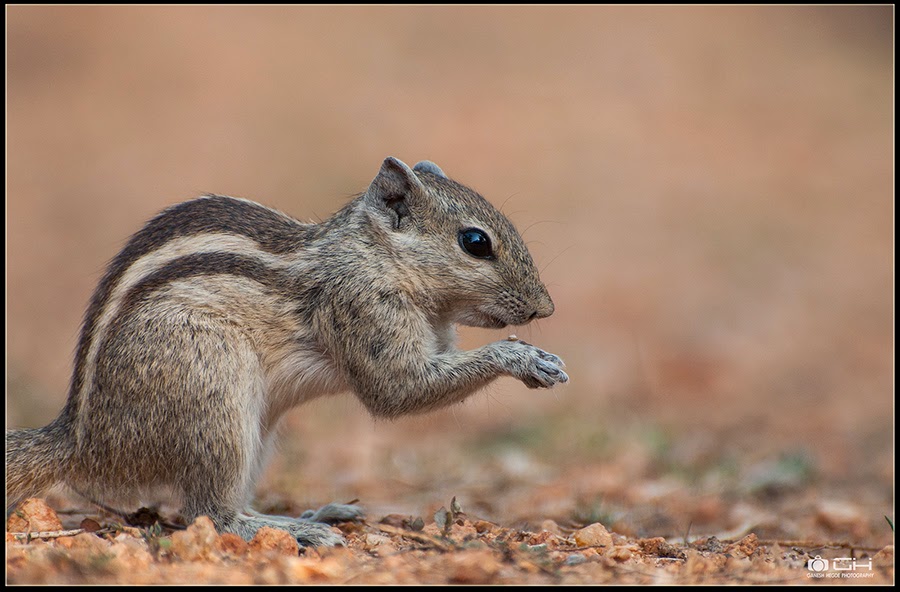Protected areas are the best place to watch and study all
types of wildlife. In these areas human interference and disturbance on their habitats and on their behavior is minimum . One can spot many rare animals and birds, especially those which are now absent in degraded habitats. In Karnataka the arid and semi-arid region occupies most of its northern part and majority of those areas are under cultivation and only few
areas are left in which we can actually see original thorny and scrub forests un-interfered by
humans.
One of such area is Daroji Sloth Bear Sanctuary near Hospet Taluk of
Bellary District in Karnataka. Situated near World Heritage site Hampi, Daroji
is around 15km from Hospet. Around 8000ha area is under protection and is one
of the best protected dry and scrub forests available in Karnataka. Beside home
of more than 100 Sloth Bears, its also best place for bird watching for dry region birds. I, along with my collegues had a great opportunity to spend some
considerably long time in and arounpresentingeas. In this part will be presenting some wonderful moments with nature and wildlife.
In 1994 this area was declared as Sloth Bear sanctuary in order to protect
endangered Sloth Bears. As a part of management and to enhance tourism inside the sanctuary, in the beginning, at some
particular places food was provided sloth bears at regular intervals. This has
been reduced over years and today no such food is provided and only some
jaggery is applied on some rocks in tourism zone. We had some splendid moments with this mother bear with its two cubs.
Apart from Sloth bears this sanctuary is home for many wild
creatures such as Leopards, Porcupine, Pangolins, reptiles and number of birds.
Every undisturbed forest habitat has its own beuty.
Landscapes around Daroji in evening light looks spectacular. This one is from
top of the visitors watch tower.
Another major attraction of Daroji is birds.It is one of the best place for birding in Karnataka. Open habitat,
scrub jungles and rocky terrain makes suitable place for many ground dwelling birds. Around
126 species of birds are recorded from here.
1. Painted Spurfowl (Galloperdix lanulata)
This beautiful bird is the icon bird of Daroji Sloth Bear
Sanctuary. It’s a medium sized ground bird belongs to Pheasant family and believed
to be monogamous. They are found in rocky hill and scrub forests.
 |
| male |
 |
| female |
2. Grey Francolin (Francolinus pondicerianus)
Grey Francolin or Grey Patridge is one of the common, medium sized ground dwelling bird found in dry regions of Indian subcontinent. In northern parts of the country its domesticated for fighting.
3. Painted Sandgrouse (Pterocles indicus)
It is medium sized bird found in dry regions of India and Pakistan. When disturbed they sit on the ground and its difficult to spot them at that time.
+(2).jpg) |
| male |
.jpg) |
| female |
4. Indian Eagle Owl (Bubo bengalesis)
Also called as Rock Eagle owl which is a large horned owl found in hilly and rocky scrub forests. Here in Daroji they can be seen along rocky cliffs of canals.
In between we also had a great moment with a Indian Star Tortoise, a small tortoise found in dry and scrub forests. This species is now becoming endangered due to exotic pet trade.
Indian Palm Squirrel close-up.
In the duration of the stay I have recorded around 85 species of birds and able to photograph around 50 species.
 |
| 5. Common Babbler |
.jpg) |
| 6. Spotted Owlet |
 |
| 7. Jungle Bush Quail |
 |
| 8. Rock Bush Quail |
 |
| 9. Indian Silverbill |
 |
| 10. Brahminy Starling |
 |
| 11. Indian Robin (female) |
 |
| 12. Red-vented Bulbul |
 |
| 13. Rose-ringed Parakeet (female) |
 |
| 14. Pied Kingfisher |
 |
| 15. Common Iora (male) |
 |
| 16. River Tern |
 |
| 17. Yellow-billed Babbler |
.jpg) |
| 18. House Sparrow (male) |
 |
| 19. Purple-rumped Sunbird (male) |
 |
| 20. Scaly-breasted Munia |
+(12).jpg) |
| 21. Spot-billed Duck |
There are many more images I would like to share and will share soon. Hope you enjoyed and had a glimpse of natural beauty of Daroji.
Regards,
Ganesh Hegde















.jpg)
+(2).jpg)
.jpg)
+(8).jpg)



.jpg)











.jpg)


+(12).jpg)
-(2).jpg)
-(4).jpg)
_2.jpg)
.jpg)
.jpg)



.jpg)



-(2).jpg)
-(2).jpg)
-(2).jpg)





.jpg)
.jpg)

.jpg)



.jpg)

